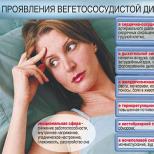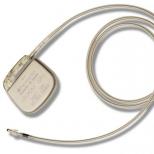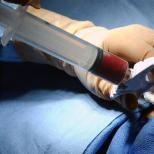VSD in adolescence
The period of puberty for many is overshadowed by the occurrence of symptoms of disruption of the nervous system, which lead to subsequent changes in the activity of various organs. Children make complaints that do not fit into the framework of any specific disease, which makes it difficult to identify the specific etiology of these manifestations. Such a symptomatic combination is called vegetative-vascular dystonia (VVD) of the pubertal period.
Reasons for the development of the disease
IRR in adolescents, as a rule, is the result of the inconsistent development of various body systems at this age. There is a pronounced contrast between body growth and changes in the cardiovascular and nervous systems in children. Against this background, the autonomic nervous system ceases to perform its function sufficiently, which leads to the appearance of symptoms of several diseases at once, which usually occur as separate, unrelated diseases at a different age. The onset of vegetative-vascular dystonia in adolescents most often occurs at 14-16 years of age.
Puberty is a difficult time for boys and girls, when there is an increased production of hormones and it is difficult for the body to cope with a large amount of biologically active substances. Their excess affects the emotional state of the child, which is closely related to the work of the autonomic nervous system. Against this background, vegetative-vascular dystonia can also develop. As a rule, if a child is anxious, hard to adapt in a team, prone to stressful conditions, there is a high probability of this disease.
Features of the manifestation of the disease
An imbalance in the work of the main body systems leads to symptoms that may not appear at all in some patients, while in others they can be combined into syndromes.
The most frequently determined signs of vegetative-vascular dystonia in adolescents:
- failure in the rhythm of heart contractions, tachycardia;
- pain in the heart, a feeling of lack of air;
- drops in blood pressure;
- increase in body temperature;
- sweating and at the same time coldness in the limbs;
- fatigue, irritation;
- headaches, dizziness, possible fainting;

In parallel to the general physiological symptoms, mental manifestations are very often added, which give children at the age of 14 no less worries than the disease itself. These include depression, various fears. The child may be depressed, overly suspicious and irritable. Bad mood is his constant companion.
VSD types
Vegetative-vascular dystonia in adolescents is of three types. They have different symptomatic pictures:
- IRR for hypertensive type manifested by increased blood pressure, tachycardia (increased heart rate), flashing "flies" before the eyes, chills, headache, loss of appetite and sweating. Moreover, blood pressure can increase not only with an increase in physical activity or mental stress, but also in a state of complete rest. There is anxiety and tension. At any moment, a crisis can begin, accompanied by panic, overexcitation and an increase in already existing symptoms.
- VSD by hypotonic type characterized by a decrease in blood pressure, bradycardia (decrease in heart rate), lethargy, weakness, pallor of the skin, sweating in combination with chills. The patient is irritable, prone to fainting. Nausea may be present. IRR of the hypotonic type increases intestinal motility and causes increased secretion of enzymes, which brings additional discomfort to the child, manifesting itself in the form of diarrhea, heartburn and rumbling in the abdomen.
- VSD by vagotonic type is determined by the presence of pain in the adolescent heart, dysfunction of the gastrointestinal tract (nausea, vomiting, constipation), increased secretion of the sebaceous glands. Patients with VSD of the vagotonic type are anxious, have a tendency to obesity, suffer from insomnia, get tired quickly, and have swelling of the extremities.
Such manifestations of VVD according to the vagotonic type are a real misfortune for a teenager, which leads to limitations of his capabilities and reduces the quality of social life. Obesity becomes the basis for the development of pubertal complexes, deprives confidence and contributes to the development of isolation.
A drop in blood pressure can cause reddening of the skin. A teenager will be embarrassed by such manifestations, which can lead to social phobia.
Syndrome of autonomic dysfunction in adolescents
The sinus node is responsible for maintaining the correct rhythm of contractions of the heart muscle. In adolescence, when the autonomic nervous system does not cope with its function and this affects the functioning of the node, disturbances in the rhythm of the heart, such as arrhythmias, may appear.
The deviation in the activity of the heart muscle is called autonomic dysfunction of the sinus node. For adolescence, this is a fairly common occurrence. It can manifest itself in varying degrees - from mild symptoms, such as a slight change in the rhythm of heart fluctuations, fatigue, unreasonable bad mood, to serious cardiac dysfunction, dangerous to the health and life of the patient.
When the syndrome of autonomic dysfunction in the pubertal period passes in a mild form, doctors often tend to choose non-intervention tactics and only observe the child. As a rule, in many cases, the function of the nervous system is improving, and the disease goes away on its own. But if the manifestations of autonomic dysfunction are serious and affect the quality of life of a teenager, then medication and, in especially severe cases, surgical treatment are clearly indicated.
Therapeutic methods for the treatment of VVD
The choice of treatment for vegetative vascular dystonia during puberty depends on the severity of the manifestations of the disease. If it proceeds in a relatively mild form, then the doctor prescribes non-drug therapy.
It includes:
- Strict observance of the regime. It is necessary to ensure that the child sleeps at least 8-9 hours, does not overwork and alternates study with rest. It is necessary to exclude or minimize computer games or watching TV in order to remove the psycho-emotional burden.
- Introduce sports and other physical activities into the norm. Classes should be regular, but not tiring. Ideal for swimming, cycling, outdoor activities, running, table tennis, etc.
- Ensure proper nutrition containing sufficient amounts of fats, proteins and carbohydrates. Make a bias on plant foods and minimize the intake of spicy, salty and smoked foods, as well as carbonated drinks, strong tea and coffee.
- An excellent effect in vegetative-vascular dystonia in adolescents is given by physiotherapeutic procedures: therapeutic baths, massage, reflexology, contrast showers, magnetotherapy.
- Phytotherapy is successfully used - decoctions of motherwort, wild rose, lemon balm. With low blood pressure, the attending physician prescribes aralia, ginseng, lemongrass.
It is very important to improve the psychological atmosphere in the family, if necessary, change the nature of communication. In some cases, psychological counseling is required.
If non-drug treatment of vegetative-vascular dystonia does not give the desired result, then the doctor prescribes medications:
- Soothing - valerian, glutamic acid, glycine, etc.
- Complexes of vitamins and minerals.
- Nootropics - Pantogam, Piracetam, etc.
- Medications to maintain blood pressure.
In severe cases, it is necessary to treat with antidepressants.
Reminder for parents
VSD of adolescence should not be ignored. If the treatment of VVD does not require drug therapy, then it is necessary to consult a doctor about the pathology of the heart and blood vessels. All recommendations must be taken into account in order to avoid serious complications of this disease in the future. From childhood, it is necessary to accustom the child to a healthy and active lifestyle and create a favorable atmosphere in the family.





